Jeremy Kyncl is new to boatbuilding, but he certainly isn’t new to woodworking and traditional crafting. He grew up in Denver, Colorado, but moved to the Pacific Northwest when he was 19. He graduated from Bastyr University in Kenmore, Washington, having studied the science, history, and traditions of medicinal plant usage. In 2019, after a seven-year spell in Spokane, Washington, where he and his wife, Michelle, had started Hierophant Meadery, they moved to a 1915 homestead on Whidbey Island with their two young sons, George and Leos. They relocated the meadery to the island and focused on bringing together their knowledge of plants and love for native culture in a business based largely on traditional methods and the ethos of respecting and working with nature rather than against it.
Life on an island suits the family. They love anything that involves being on and in the water: body surfing, swimming, boating. When they first moved to Whidbey, Jeremy and Michelle bought a fiberglass lake canoe, but it was heavy, and loading it on the car was a strain; plus, Jeremy felt its low freeboard made it unsuitable for use on the Puget Sound waters that surround Whidbey. Familiar with building and fixing around the homestead, Jeremy now turned his thoughts to boatbuilding.

The construction technique was purely traditional, but for the lashings and skin Jeremy sourced modern materials: ballistic nylon for the skin, waxed nylon for the lashings.
“I wanted something light enough to cartop myself, seaworthy enough to handle being out on Puget Sound, and kind enough for a first-time boatbuilder.”
Through 2021 Jeremy pored over books and websites, plans and magazines. He remembers spending about six months “looking at all the usual suspects in small-boat design.” When he stumbled upon Building Skin-on-Frame Boats by Robert Morris, he “fell in love with the ingenuity, simplicity, and efficiency of the technique.” Having spent time in the Scouts, he was confident he had the skills for the necessary knotwork.
Jeremy set about figuring out which skin-on-frame boat he would build. He knew he wanted to go with a “home-grown Northwest hull form,” but it would be another two months before he decided on a native Pacific Northwest canoe. Then he found a drawing of a Nootkan cedar dugout that was used for trade in North Puget Sound in 1905. He was attracted to the shape and decided he would make a skin-on-frame version.
“The original hull was 25′6″ with a 42″ beam. That was too big for us,” he says, “so I scaled it back to 17′6″ with a beam of 36″.” With three adults on board, the canoe draws only 4″. The bare frame weighs 44 lbs.
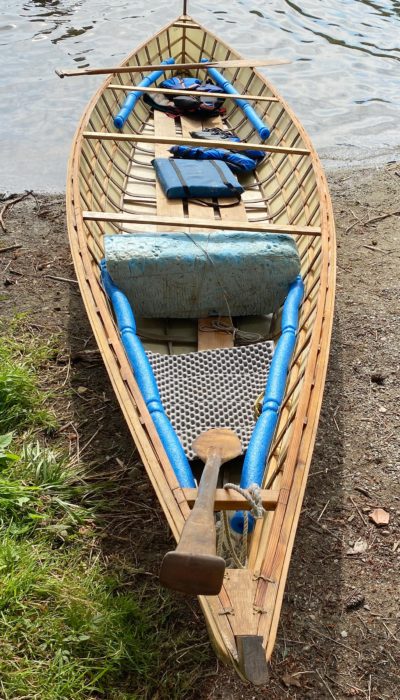
For her first season MUSE had temporary crossbeams that gave the canoe structural strength but were not strong enough to support the weight of a person. Jeremy plans to replace them with better-sized split-cedar posts. Similarly, MUSE was launched without seats. Instead, the family made use of a Styrofoam block and a cooler. The Styrofoam also provided buoyancy, as did the four swim noodles tied to the frame.
Jeremy sourced all the materials locally and even incorporated salvaged wood and driftwood. The breasthooks were fashioned from a barrel that came from a local winery and “never did get filled with mead at our facility.” The stem knee came from a cherry tree on the homestead, and the stern knee was milled from windfall Douglas-fir found in the woods that border the property. The stringers were split from red-cedar driftwood.
Jeremy began the build in the first week of January 2022, and for the next three months he worked on the canoe every Tuesday. There was an unplanned interruption for most of March and April, but by May he was back on track and hard at work.
Throughout the build, Jeremy sought and received plenty of good advice. Corey Freedman of Spirit Line Kayaks was a “huge help, as were the folks at Cape Falcon Kayak in Portland, Oregon.” Both organizations supplied information and materials, especially in the early research stages when Jeremy was getting himself “mentally prepared for the task at hand.” And when it came to the actual construction, there was help closer to home: “the boys helped with the myriad lashings.”
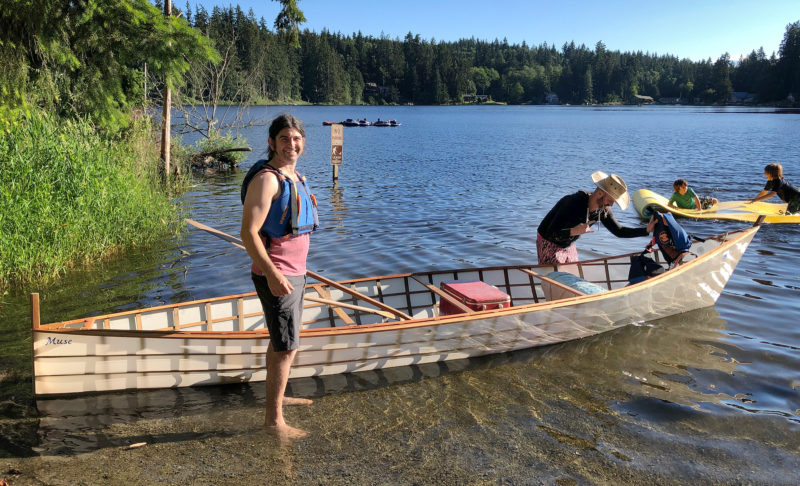
With her minimal draft, MUSE is the ideal boat for exploring the shallows at the lake. Her unloaded weight is under 50 lbs, making her easily cartoppable, even when Jeremy is on his own—a rare occurrence in MUSE’s first season.
Inevitably, as with most first builds, not everything went according to plan. “One thing I would definitely do differently,” says Jeremy, “would be to use oak instead of laminated bamboo for the ribs. It was difficult to get the bamboo soft enough to bend without delaminating the glue joints.” While that can’t now be changed, Jeremy is thinking of redoing another part of the boat: “I didn’t get the skin as tight as I would have liked, so I’ll probably replace it relatively soon.” He would also like to modify the chines, which make very sharp corners and subject the fabric to excessive abrasion. If Jeremy does replace the skin, he will be able to round the edge of the chine so that the abrasion won’t be focused on such a small area.
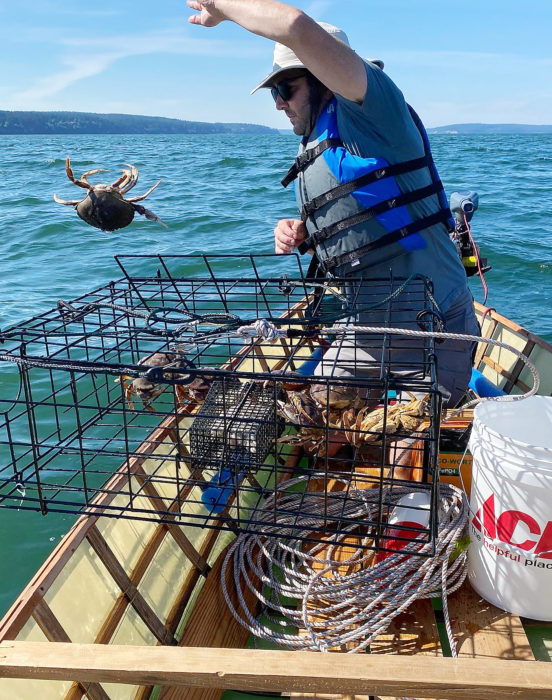
Not every crab is a keeper. The family used MUSE extensively for crabbing and fishing in her first season, confirming that Jeremy was right to believe an indigenous boat type would prove its worth and suit the needs of the family.
By late June, summer had arrived, and the family was eager to be afloat. One hundred hours into the build, the canoe was far enough along to be used. The seats were not yet installed, but there’d be plenty of time for that and the other tweaks over the winter. There was crabbing and gunkholing and salmon fishing to be done, to say nothing of days at the lake swimming and lounging in the sun. For the summer of 2022, passengers and crew could sit on the floor, a cooler, or a block of Styrofoam.
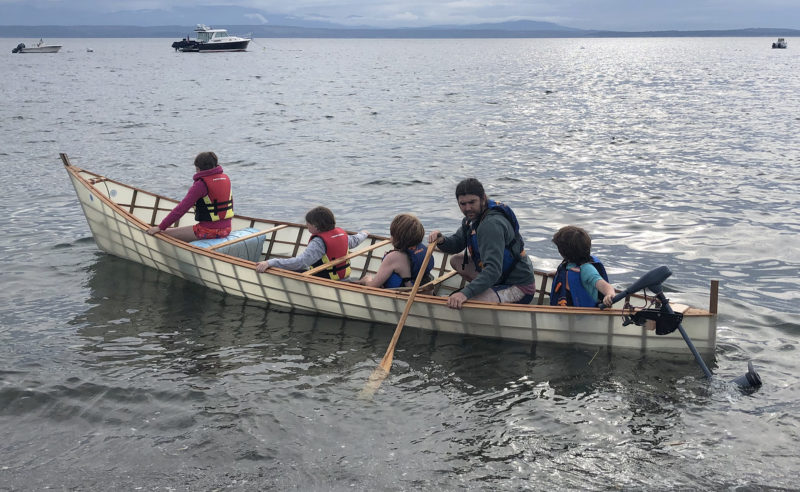 Photographs courtesy of Jeremy Kyncl
Photographs courtesy of Jeremy KynclThe canoe is light enough to be powered by a small electric trolling motor, but sturdy enough to accommodate family and friends.
The Kyncls launched MUSE on June 30, 2022, in Goss Lake, “our favorite little lake on Whidbey.” It was the first of many outings.
“We loved our first year,” says Jeremy. “I love that I can launch anywhere that has a parking lot by the beach, and that we can slip into bays with just inches of water. She’s a real joy. A lively little boat. With the electric trolling motor—which both boys quickly learned to operate—she rode happily and proved game for the chop and blustery conditions common off Whidbey. There’s a steady, peaceful ease to how she carries herself and happily surfs downwind waves.”
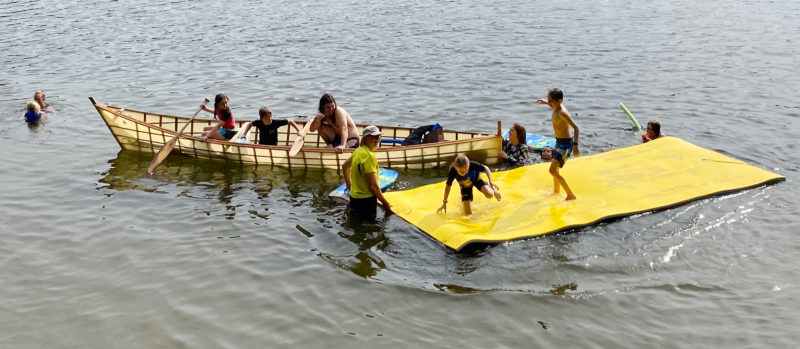
Simple pleasures: MUSE became the much-loved ferry and focal point for multiple schoolchildren at the lake in her first summer.
Between catching Dungeness crab—“we’ve paid for the cost of the build with the amount we’ve eaten”—and acting as passenger ferry for “half the school at the swimming hole,” MUSE is, says Jeremy, just what he hoped for when he set out to build her and he’s glad to have taken “so many hints from thousands of years of indigenous experience.”![]()
Jenny Bennett is the managing editor of Small Boats Magazine.
Do you have a boat with an interesting story? Please email us. We’d like to hear about it and share it with other Small Boats Magazine readers.
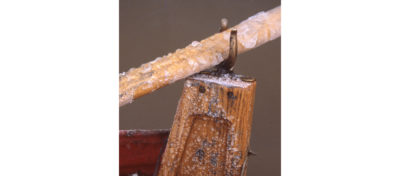



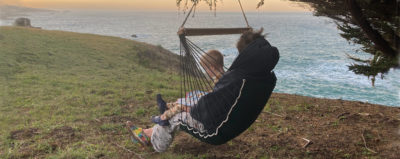

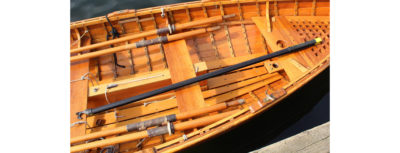


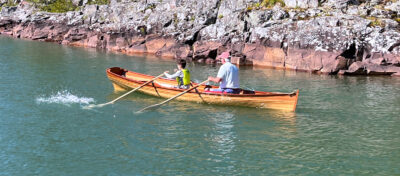
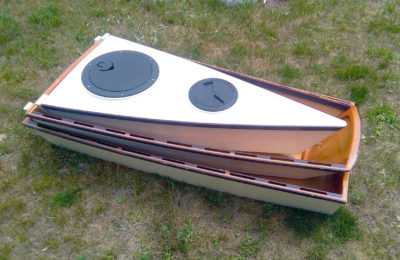
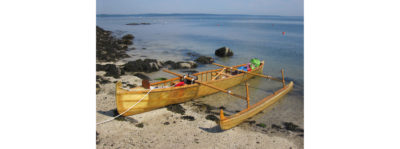
It’s a beautiful boat, it’s lines reminiscent of a Nootka canoe, and it’s size is almost the same as a wood/canvas canoe I built 49 years ago, 17′ x 36″, framed in spruce and oak with yellow-cedar frames and red-cedar planking. It’s a good canoe, still seaworthy, but it weights 83 lbs, too heavy for my broken-down old back, so MUSE looks like a good alternative, and it looks fun to build, as well. Thank you for the article; it was very enjoyable.
Use polyester for the next skin, nylon absorbs water, probably never get it tight.
Kenneth is totally correct about polyester. Readily available in different weights; for MUSE you’d want to go with a heavier (10-oz) fabric weight. You can heat-shrink it to tighten beyond what you can pull, but practice first with some fabric stretched over a frame. Polyester has good abrasion resistance. I recovered a wood/canvas canoe with light polyester, and paddled it for years with little concern about sliding over gravel, etc. and it only picked up a few scuff marks.
May I ask an obvious question? On the canoe you covered, did you paint or epoxy the skin for waterproofing?
I used a two part catalytic urethane from Spirit Line, but that’s far from the only option.
I went with the nylon from Spirit Line because I could pick it up within an hour of home and also because it was going to see a lot of barnacle-encrusted cobble beaches and I wanted the best abrasion resistance I could get. So far the ribs are well clear of the skin even with four adults aboard, so it did get tight enough for our needs. Thankfully, it’s a workboat at heart so having a few wrinkles in the skin after a night’s dew isn’t a deal breaker. I’ll definitely look into polyester more when it’s time to reskin, perhaps I’ll find my concerns about abrasion were overblown after years of using the hull.
A neat article! I thought I would pick up a copy of “Building Skin-on-Frame Boats” so looked it up on ABE Books – WOW! The used price is too much for this old retired fellow….
I know that borrowing is not as satisfying as owning a copy, but your local public library would be happy to find it for you via Inter-Library-Loan!
And there’s an alternative, available at a much lower price, in Building the Greenland Kayak by our editor here at Small Boats, Christopher Cunningham!
A scanned copy of the book is available on Archive.org. Search “skin-on-frame boats”. You will need a free account to be able to read it online. Unfortunately you can’t download it, but it is a good, free alternative.
Great writing. You’ve beautifully and succinctly captured Jeremy’s creativity, as well as the spirit of South Whidbey. Jeremy’s Dad